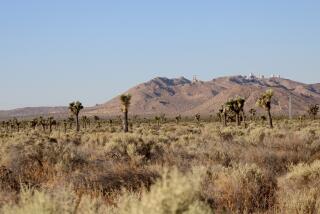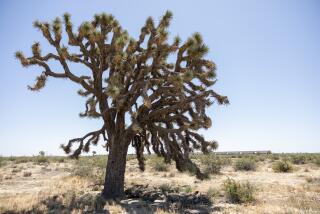Partners May Pull Out of Squirrel-Delayed Observatory
- Share via
A court ruling that temporarily blocks further construction on the University of Arizona’s proposed astronomical observatory threatens to kill the $200-million project, officials on the Tucson campus warned Wednesday.
The U.S. 9th Circuit Court of Appeals on Tuesday issued an injunction barring the university from proceeding with the project until December. At that time, the court will consider an appeal filed by environmentalists worried that placing telescopes on a southeastern Arizona mountaintop threatens an endangered red squirrel living there.
The ruling means that no progress on the observatory can be made before winter snows cloak Mt. Graham, the 10,700-foot peak that an international team of astronomers wants to use as a perch for the world’s most powerful and sophisticated land-based telescopes.
“We’ve lost another year, and that makes it extremely difficult to hold the project together,” said astronomer Roger Angel, director of the laboratory that is creating mirrors for the giant telescopes. “Our partners have been waiting a long time, and they are losing patience with this continuing nonsense.”
Specifically, the Max Planck Institute of West Germany has begun looking in Chile for an alternative site for its sub-millimeter telescope, the first of three instruments planned for the observatory’s initial phase.
“Their telescope is built, it’s sitting in boxes in West Germany waiting to be shipped somewhere and put together,” university spokesman Steve Emerine said. “The scientists want to get going, and they are actively looking for another location.”
The Vatican Observatory--founded by Pope Leo XIII in 1891--is another participant growing antsy over the continuing delays. Emerine said the Vatican’s telescope arrived in Tucson in June and “is sitting in a warehouse, all ready to go.”
And Ohio State University, co-sponsor of a $60-million telescope that would have the largest light-gathering capability of any land-based instrument in the world, also may soon “give up on Arizona,” Angel said.
If these prestigious partners pull out, the university would be hard pressed to find replacements willing to invest in a project so clouded by uncertainty, officials said.
The Mt. Graham venture is “clearly at risk,” concluded Peter Strittmatter, director of the university’s Steward Observatory.
Opponents of the project, elated by their eleventh-hour court victory, said they were encouraged by the news that the observatory’s backers may be having second thoughts about Mt. Graham.
“I hope there is truth to that,” said Robin Silver, spokesman for the Maricopa Audubon Society in Phoenix, “because they have previously disregarded the clear, biological consensus against putting telescopes on that mountain.”
The Mt. Graham red squirrel, once abundant in the mountain’s thick forests, has dwindled in numbers because of piecemeal losses of habitat. The reddish-brown animal, found only on Mt. Graham, was added to the nation’s list of endangered species in 1987.
Some surveys now place the population at 132. But university biologists say the figure is much higher, and they argue that clearing one acre of spruce and fir trees for the observatory would not imperil the squirrel.
BACKGROUND
The ruling by the U.S. 9th Circuit Court of Appeals is the latest twist in a saga that dates to 1984, when the university--a recognized leader in astronomy--first began pursuing the Mt. Graham International Observatory. Although supported by scientists who said the project would help launch the next era of astronomy, university officials were met with opposition from biologists who fear it will push the Mt. Graham red squirrel to extinction.
More to Read
Sign up for Essential California
The most important California stories and recommendations in your inbox every morning.
You may occasionally receive promotional content from the Los Angeles Times.













